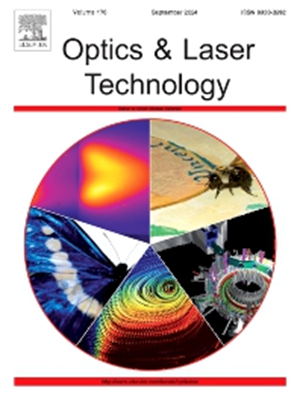Efficient high-power 1.9 µm picosecond Raman laser in H2-filled hollow-core fiber without generation of rotational lines
IF 4.6
2区 物理与天体物理
Q1 OPTICS
引用次数: 0
Abstract
In this paper, an efficient high-power 1.9 µm picosecond Raman laser through pure vibrational stimulated Raman scattering (SRS) in H2-filled hollow-core fiber (HCF) is demonstrated. The maximum Raman conversion efficiency of 34 % and the Raman power of 7.3 W (36.5 µJ) is achieved within a 130 cm length of our in-house fabricated fiber. By controlling the H2 pressure, the high-order Stokes and rotational Stokes/anti-Stokes will not be generated, thereby enhancing the efficacy of the 1st Stokes conversion. In addition, the vibrational anti-Stokes are produced inevitably, which can be explained by the phase-matching of higher-order modes. Our results show SRS in H2-filled HCF to be a promising method for generating high-power 1.9 µm picosecond pulses, which are valuable in spectroscopy, defense, and efficient nonlinear conversion.
填充 H2 的中空芯光纤中的高效大功率 1.9 µm 皮秒拉曼激光器,不会产生旋转线
本文通过在充有 H2 的中空芯光纤(HCF)中进行纯振动激发拉曼散射(SRS),展示了一种高效的 1.9 µm 皮秒拉曼激光器。在我们自行制造的 130 厘米长的光纤中,实现了 34% 的最大拉曼转换效率和 7.3 W(36.5 µJ)的拉曼功率。通过控制 H2 压力,不会产生高阶斯托克斯和旋转斯托克斯/反斯托克斯,从而提高了第一斯托克斯转换的效率。此外,振动反斯托克斯不可避免地会产生,这可以用高阶模式的相位匹配来解释。我们的研究结果表明,在充满 H2 的 HCF 中进行 SRS 是产生高功率 1.9 µm 皮秒脉冲的一种很有前途的方法,这种脉冲在光谱学、防御和高效非线性转换方面很有价值。
本文章由计算机程序翻译,如有差异,请以英文原文为准。
求助全文
约1分钟内获得全文
求助全文
来源期刊
CiteScore
8.50
自引率
10.00%
发文量
1060
审稿时长
3.4 months
期刊介绍:
Optics & Laser Technology aims to provide a vehicle for the publication of a broad range of high quality research and review papers in those fields of scientific and engineering research appertaining to the development and application of the technology of optics and lasers. Papers describing original work in these areas are submitted to rigorous refereeing prior to acceptance for publication.
The scope of Optics & Laser Technology encompasses, but is not restricted to, the following areas:
•development in all types of lasers
•developments in optoelectronic devices and photonics
•developments in new photonics and optical concepts
•developments in conventional optics, optical instruments and components
•techniques of optical metrology, including interferometry and optical fibre sensors
•LIDAR and other non-contact optical measurement techniques, including optical methods in heat and fluid flow
•applications of lasers to materials processing, optical NDT display (including holography) and optical communication
•research and development in the field of laser safety including studies of hazards resulting from the applications of lasers (laser safety, hazards of laser fume)
•developments in optical computing and optical information processing
•developments in new optical materials
•developments in new optical characterization methods and techniques
•developments in quantum optics
•developments in light assisted micro and nanofabrication methods and techniques
•developments in nanophotonics and biophotonics
•developments in imaging processing and systems

 求助内容:
求助内容: 应助结果提醒方式:
应助结果提醒方式:


